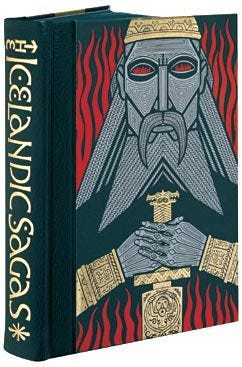Books & Culture
Founding Fathers and Pagan Goddesses
Geek Reads Looks at Halldór Laxness’s most radical novel, Christianity Under the Glacier

Electric Lit is just $4,000 away from our year-end fundraising goal of $35,000! We need to hit this target to get us through the rest of 2025, and balance the budget for 2026. Please give today! DONATE NOW.
Iceland’s sole Nobel laureate Halldór Laxness (1902–1998) published twenty-two novels, among many other things, during his long career. I’ve not read all of them, but of those I have Kristnihald undir Jökli strikes me as by far his strangest, his funniest, and his most radical. Susan Sontag once declared, “It is like nothing else Laxness ever wrote” and I’ll take her word for it. I’m also told that it was the last novel he completed before turning to playwriting.
The English-language translation we have is called Under the Glacier, but the literal title is something closer to Christianity Under the Glacier, and it was first published in 1968. That was a time, some of us will recall, of tremendous transformation and upheaval in the arts. The staid and dominant order was breaking down. It was the year of the White Album and White Light/White Heat, of Planet of the Apes and 2001: A Space Odyssey. Disruption was in the air. New and radical ideas permeated the popular culture to such an extent that the very notion of a popular culture finally became suspect. Adventurous artists in seemingly every medium broke free of the old strictures.

Christianity Under the Glacier did likewise. To the best of my admittedly limited knowledge, it seems like an aberration in Laxness’s oeuvre, a change in direction — and the end result of decades of writing novels. There’s little that’s traditionally Christian about Christianity Under the Glacier. Although he had referenced and retold and relied upon the medieval Sagas of the Icelanders innumerable times, this particular novel strikes me as his greatest effort to launch an entirely new and secular — which is to say profane — epic saga of his own.
Disruption was in the air. New and radical ideas permeated the popular culture to such an extent that the very notion of a popular culture finally became suspect.
I don’t feel like there’s any need to mansplain the continued relevance or vitality of the Sagas of the Icelanders, but it is difficult to discuss the works of Halldór Laxness without giving them their due. From what we can tell, the mythic histories that constitute those Sagas were recorded in the fourteen, fifteen, and sixteen-hundreds, the height of the Middle Ages. Like the Old English poem of Beowulf, the Icelandic Sagas were Christian-era tellings of stories about great pagan heroes and deeds of the past.
It was the Russian formalist critic M.M. Bakhtin who, in his essay “Epic and Novel: Toward a Methodology for the Study of the Novel,” distinguished the novel from the epic. It’s a distinction that Laxness would undermine in Christianity Under the Glacier. Bakhtin’s essay also detailed three primary characteristics of an epic, all of which we see in the Sagas.
First, an epic will likely describe a “national epic past” or “absolute past” of a particular place. Second, the epic could be said to detail national traditions rather than the personal or individual experiences of its peoples. Third, and I think most interestingly, the epic establishes absolute distance that “separates the epic world from contemporary reality, that is, from the time in which the singer (the author and his audience) lives.”

To Bakhtin’s point, the Sagas clearly demarcate the bygone heathen epoch from their Christian retellings. In doing so, they also serve as the epic origin myths of Iceland — of that “national epic past.” Bakhtin may well have had the Sagas of the Icelanders in mind when he wrote: “The world of the epic is the national heroic past: it is a world of ‘beginnings’ and ‘peak times’ in the national history, a world of fathers and of founders of families, a world of ‘firsts’ and ‘bests.’”
The ugly phallocentrism on display here is no accident. Here in the United States, when we refer to the so-called “Founding Fathers” of our nation we are casting them and their actions in epic terms. In valorizing the drafting of the Declaration of Independence, for example, we risk making it impervious to criticism. We pretend that the framers were not, for example, misogynistic slave owners.
Iceland’s own mythic and heroic past is the subject of many of those Sagas and, we will see, of Laxness’s eventual subversion of them in Christianity Under the Glacier. That novel cuts through the cheap historiography. It tells the story of a Pastor in a remote village who abandons the conventions of the church and begins what appears to be a new tradition. In effect, Laxness has invented an entirely new saga, one reflective of the counter-cultural anti-authoritarianism and searching secularism of the late 1960s.
In valorizing the drafting of the Declaration of Independence, for example, we risk making it impervious to criticism. We pretend that the framers were not, for example, misogynistic slave owners.
The story is recounted in notes compiled by a parish clerk named Tumi Jónson, who is hired by the Bishop of Iceland to travel to the remote settlement of Snæfellsjökull (or Snæfells Glacier). He’s there to check up on the local pastor, who has been neglecting his duties. Rumors abound that the pastor no longer buries the dead but instead has them placed on the glacier itself.
When Jónson arrives, he finds that things are even more bizarre than he had been led to understand. In his report, he writes: “As far as the undersigned can see, Christian observance is at a minimum in the district.” And, “clerical duties are hardly performed at all in the parish unless ministers from outside are called in. Burials neglected. No services at Christmas, etc.”
Pastor Jón — who also goes by the name Prímus — had deviated so far from his Christian duties that he has more or less begun a new cult. Jónson’s account of his time there describes the beginning and perhaps the founding of a decidedly un-Christian community. In other words, Prímus — and of course Laxness himself — have put in motion some new and rather unorthodox local traditions.
As Bakhtin writes: “By its very nature the epic world of the absolute past is inaccessible to personal experience and does not permit an individual, personal point of view or evaluation. One cannot glimpse it, grope for it, touch it; one cannot look at it from just any point of view; it is impossible to experience it, analyze it, take it apart, penetrate its core. It is given solely as tradition, sacred and sacrosanct, evaluated in the same way by all and demanding a pious attitude toward itself.”
While that remains true of the Sagas of the Icelanders, Jónson’s experiences defy this. The epic origins of the new traditions at Snæfells Glacier are no longer “walled off from all subsequent times by an impenetrable boundary.” They are happening in the present moment in the book.
Through Prímus’s actions, Laxness peels away the centuries of religious dogma and returns his characters — and his readers — to the pre-Christian tradition of goddess worship and to the feminine origins of European mythmaking as described in, among many other sources, Robert Graves’s The White Goddess.
Graves cites a twelfth-century English book that describes the eternal goddess as: “Earth, divine goddess, Mother Nature, who dost generate all things and bringest forth ever anew the sun which thou hast given to the nations, Guardian of the sky and sea and of all Gods and powers.” He also cites how Christianity attempted to supersede the worship of the timeless goddess figures.
The goddess at the center of Snæfells Glacier and of Laxness’s new epic saga goes by many names, but she’s best known as Úa (“Ooh-a”). She provides the divine inspiration for Prímus and many others. Jónson describes her: “So wonderful was this creation that it’s no exaggeration to say she was completely unbearable” and “There was never anything like her.”
Úa is both absent and present, real and extra-real.
The Trolls in Our Midst: What Fairytales Can Tell Us about Online Behavior
Prímus says: “The Úa who came is not the one who went away. Because in the first place Úa cannot go away, and in the second place she cannot come back. She doesn’t come back because she didn’t go away. […] She didn’t remain just outwardly but above all within myself. Who could take your mother away from you? How could your mother leave you? What’s more, she is closer to you the older you become and longer it is since she died.”
Úa’s seemingly supernatural not-present presence refutes Bakhtin’s notion that “The epic world is an utterly finished thing.” Bakhtin also writes: “One can only accept the epic world with reverence; it is impossible to really touch it, for it is beyond the realm of human activity, the realm in which everything humans touch is altered and re-thought.”
The great contribution of Christianity Under the Glacier is Laxness’s insistence that that’s no longer true. The novel excises any religious dogma in favor of the ancient goddess-worship traditions that Christianity attempted to repeal and replace.
Recalling Graves’s White Goddess, Jónson comes to learn that: “The foremost women of the world all speak to me with one mouth: the Virgin Mary with the Infant on her knee; the Greek golden age with washerwoman bun and Venus from Willendorf, vulgar and Simon-pure with her face hidden behind her hair and her buttocks bare, the bitch-goddess of mythology, the Virgin Whore or Romanticism, Ibsen’s fate-woman, the Mater Dolorosa of the Gospel — but above all the good abbess, Saint Theresa from Spain, in search of a new Saint John of the Cross.”
Christianity Under the Glacier displays little reverence for the Christian origins of the Sagas of the Icelanders. It also closes any “absolute epic distance” between the events of an epic and of its later telling. The ramifications of that are radical.
What I mean is, it asks each of us to question and ultimately distrust the political agendas and machinations of epic storytelling itself. And once we rethink the orthodox stories of whatever glorified “founding fathers” we’ve been told to worship, we can then start to envision how to retell those origin stories — our own origin stories — with more honesty and more inclusivity.
[Adapted from an April 7, 2017 talk at the “Celebrating the Legacy of Icelandic Author Halldór Laxness” symposium at the University of Maine.]









